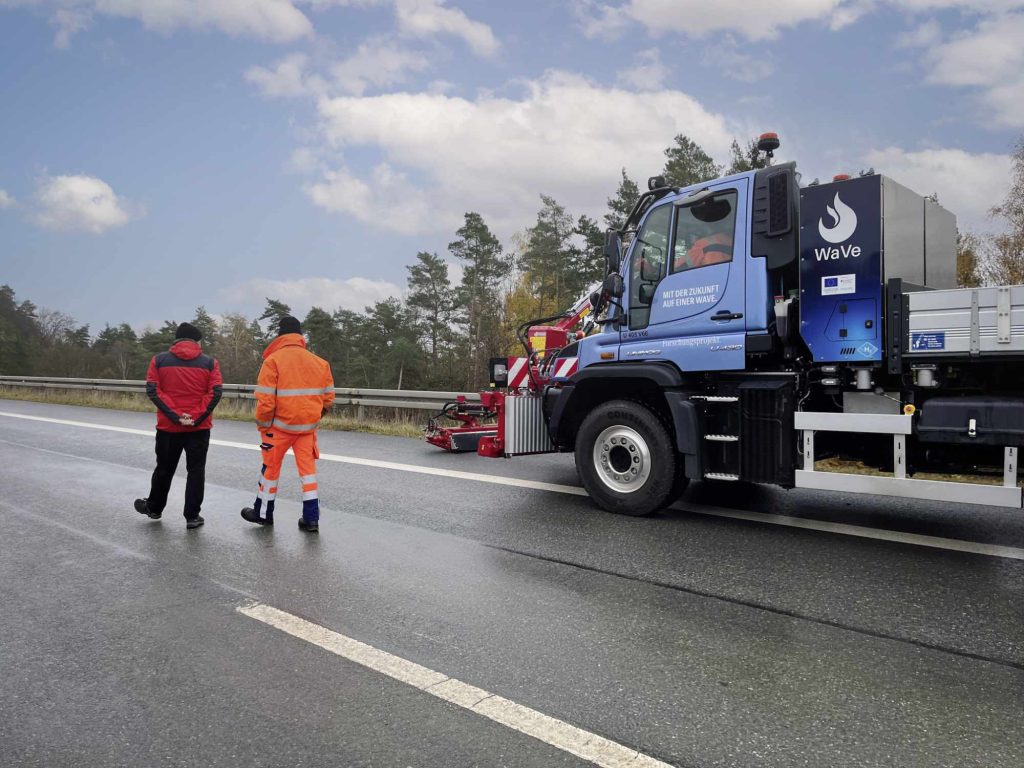Mercedes-Benz Special Trucks has tested a Unimog implement carrier prototype with a hydrogen combustion engine in real operation. The Unimog is a test vehicle that is used to research the conditions under which hydrogen combustion can be implemented as a supplement to battery-electric and fuel-cell-based drives. On a decommissioned section of the highway between Bayreuth and Bamberg, engineers collected measurement data when mowing the verge, accelerating and refueling at a public gas station. The data will be used for further vehicle development. Employees from Autobahn GmbH accompanied the tests. Practical testing at low temperatures and in varied topography is an important step in the ongoing “WaVe” development project, in which 18 partners are working together on the hydrogen combustion engine drive concept.
Franziska Cusumano, Head of Mercedes-Benz Special Trucks and Custom Tailored Trucks: “We are very happy with the current development status of the test vehicle. After a good two-year project term, we are already in practical testing with the first operational Unimog prototype featuring hydrogen combustion engine. The tests with Autobahn GmbH staff in Upper Franconia are particularly valuable for us because here we can collect important feedback from practical application for the further development work.”
Prototype vehicle with converted engine
The Mercedes-Benz Unimog test vehicle is based on the Unimog U 430 implement carrier. A specially converted natural gas engine with tank, safety and monitoring systems as well as measurement technology is installed for the alternative hydrogen technology drive. Hydrogen combustion in the engine compartment produces water, which is discharged as steam via the exhaust system. The wheelbase and platform length are dimensioned so that the hydrogen tanks can be installed behind the cab. The four TÜV-certified, 700-bar high-pressure tanks hold a total of around 14 kilograms of gaseous hydrogen. They are combined into two double tanks, each of which is operated independently of each other with a tank control unit. In a next development stage, the engineers aim to increase the volume to be able to cover a regular working day. The engine delivers around 290 hp/1000 Nm and is noticeably quieter than its diesel equivalent. The prototype was equipped with a front mower featuring two mowing heads in order to gain further insights in work mode.
Policy makers, science and business put WaVe project into action
The development of the test vehicle with a hydrogen combustion engine is taking place within the framework of the publicly funded “WaVe” project. The project, funded by Germany’s Federal Ministry for Economic Affairs and Climate Protection, is being jointly implemented by 18 partners from industry and science and started in July 2021. The objective of the WaVe project is to examine the extent to which a conventional diesel engine as a multi-energy distributor for the traction drive and all power take-offs can be substituted by a hydrogen-powered combustion engine.

Daimler Truck’s focus is on battery-electric drives and hydrogen-powered fuel cells. In addition to these two technologies, hydrogen combustion can be another option for the decarbonization of Daimler Truck’s drivetrain portfolio. Also, initial results from the WaVe project show that the hydrogen combustion engine can be a sensible, complementary solution for special applications.
Especially for the Unimog, this variant could prove to be a viable mode of propulsion for the future because of the limited installation space and the high performance required for operation involved with this type of vehicle. After the first successful practical application, the development team is looking forward to a remaining project duration of six months to make further adjustments and refinements. Dr. Günter Pitz, Head of Powertrain Development at Mercedes-Benz Special Trucks: “The hydrogen combustion drive concept can serve as a blueprint for power-intensive applications in the specialty vehicle sector. Hydrogen combustion can make it possible to drive and work with very low emissions on construction sites, in municipal or agricultural sectors. To reach series maturity for such vehicles, reliable funding is and will be required.”

